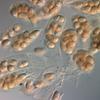Freshwater Ascomycetes - Species Monograph
Click on the pictures below to view them at their full size.
| Genus |
Species |
Author |
| Lepidopterella |
tangerina |
Raja & Shearer |
| Class |
Order |
Family |
| Dothideomycetes |
Inc. sed. |
Inc. sed |
Genbank ID:
561968
MycoBank ID:
507454
|
| Synonymy: |
|
Description
|
| Habit: |
Ascomata superficial to partly immersed on submerged wood. |
|
| Ascomata: |
Ascomata on wood 120–190 × 230–300 µm, cleistothecial, scattered to gregarious, superficial to partially immersed, globose to subglobose, appearing as raised dome-shaped structures on the substrate. |

|
| Peridium: |
Peridium 8–10 µm wide, textura angularis in surface view, in median longitudinal section composed of an outer dark brown amorphous layer and an inner hyaline region of 2–3 layers of elongated, thin-walled, angular cells. |
|
| Beak: |
Absent. |
|
| Hamathecium: |
Pseudoparaphyses sparse, hyaline, septate, not covered in gel. |

|
| Ascus: |
Asci 78–130 × 40–58 µm, (mean = 106 × 50 µm, n = 20), produced successively on ascogenous hyphae, then separating from the ascogenous hyphae, globose to subglobose, thick-walled and broadly rounded at the apex, with a short pedicel, containing eight irregularly arranged ascospores , fissitunicate, ectoascus rupturing at the apex to release the endoascus; endoascus extending to ca. 90–150 µm long; cytoplasm of discharging endoascus finely granular, with granules delimiting spheres. |

|
| Ascospore: |
Ascospores 16–19 µm long at the septum and 30–35 µm wide at the broadest point (mean = 18 × 32 µm, n = 40), papilionaceous to broadly reniform, 1-septate, bi- to multiguttulate, orange to light orange-brown, smooth-walled. |

|
| Sheath: |
Absent. |
|
| Appendage: |
Absent. |
|
| Culture: |
Colonies on PYG agar hyaline to dark greenish brown. Center of the colony composed of aerial, hyaline hyphae and immersed, brown hyphae; mycelium toward the periphery dark green to brown, slightly thick walled, immersed, and effuse. |
| Anamorph: |
None observed. |
|
Other info
|
| Type & Location: |
USA. FLORIDA: Blackwater River State Forest, Blackwater River, north end, at Kennedy Bridge, 30°56'01"N, 86°44'07"W, water 11 C, pH 5, on submerged corticated woody debris, 11 Feb 2006, HAR and JLC, F118-1. (HOLOTYPE ILL40112). |
| Other Specimens: |
|
| Substratum: |
Woody debris. |
| Habitat: |
Lotic (river) |
| Distribution: |
USA (FL) |
| Pertinent Literature: |
Raja & Shearer 2008 |
| Comments: |
The characteristics of L. tangerina fit within the concept of the genus Lepidopterella Shearer & J.L. Crane (Shearer and Crane 1980b). Lepidopterella tangerina however differs from the type of the genus, L. palustris Shearer & J.L. Crane, in ascospore morphology and size. The ascospores of L. tangerina are broadly reniform and shorter at the midseptum (17–19 µm) compared to the ascospores of L. palustris, which are deeply constricted in proportion to the overall spore morphology (butterfly shaped) and consistently longer at the midseptum (18–25 µm) (Shearer and Crane 1980b). The midseptum of the ascospore is darkened in L. palustris but not in L. tangerina. In addition mature ascospores of L. palustris are darker than those of L. tangerina. |
Additional Pictures
|
Bitunicate ascus dehiscence
|

|
|
One undehisced and two dehisced asci.
|

|
|
Dehiscent ascus.
|

|
|
Dehiscent ascus.
|

|
|
Dehiscent ascus.
|

|
|
Undehisced ascus.
|

|
|
Undehisched asci.
|

|
|
Ascospores.
|

|
|
Ascospores in matrix of endoascus.
|

|
|
Back
|
|